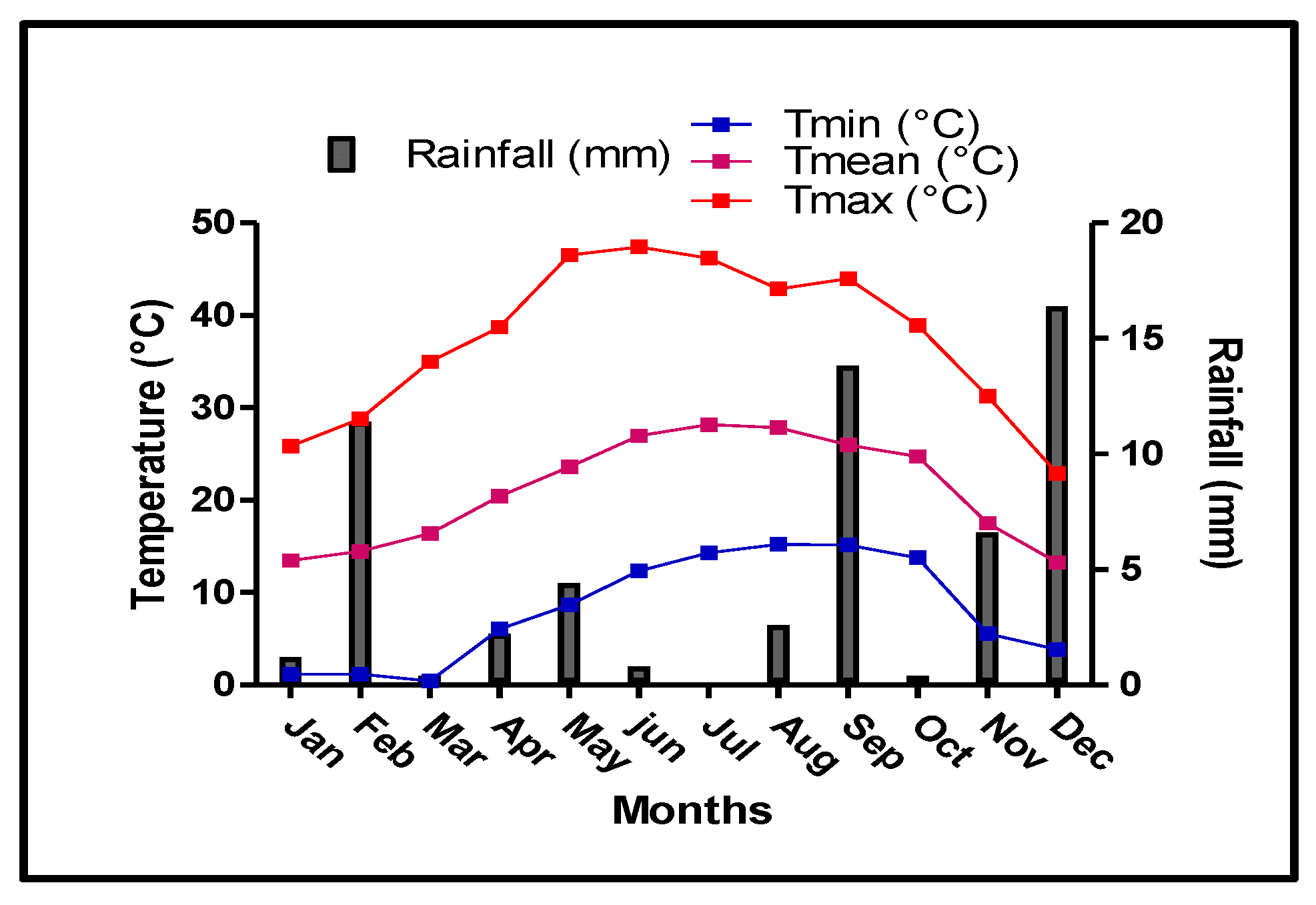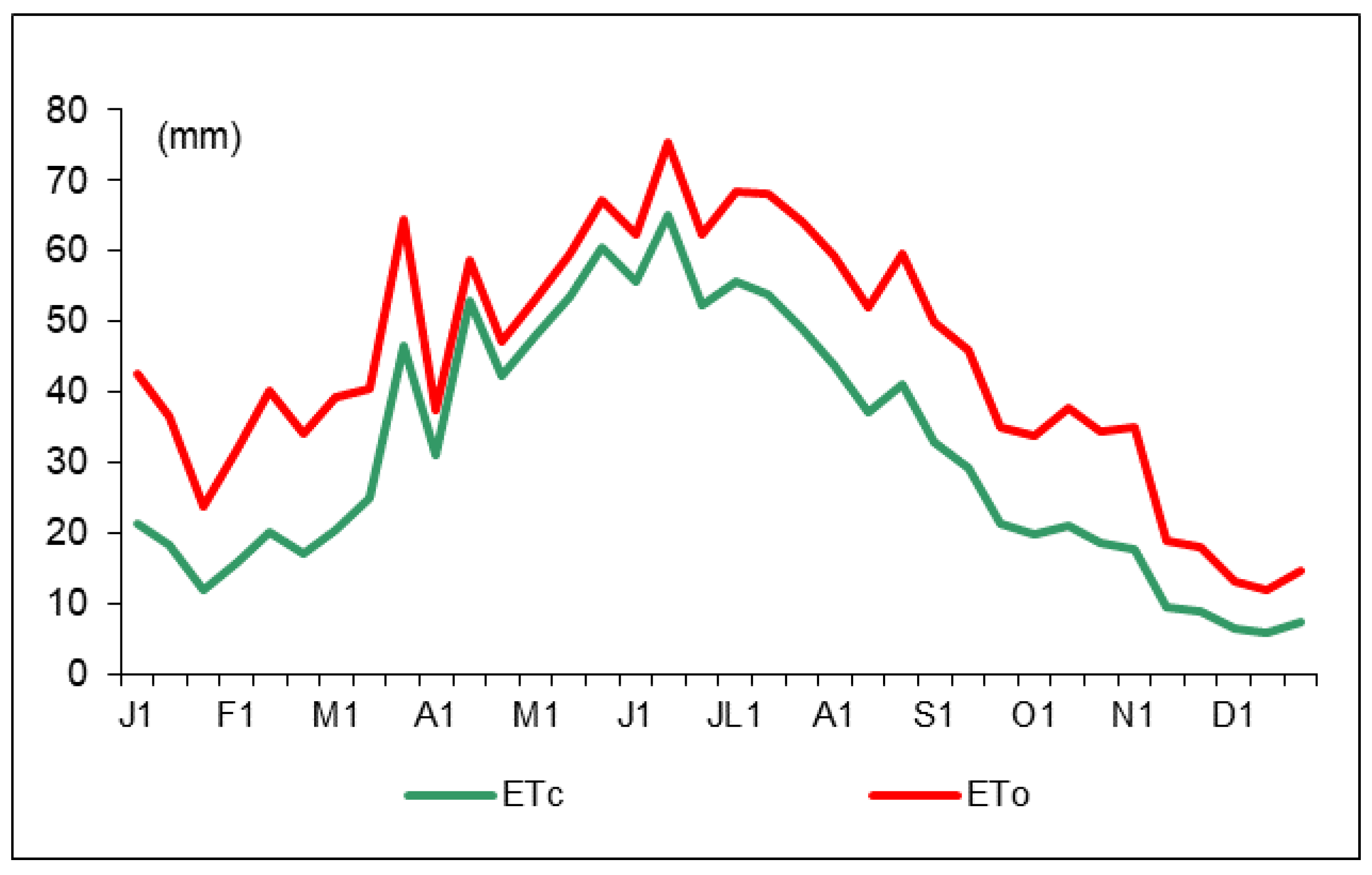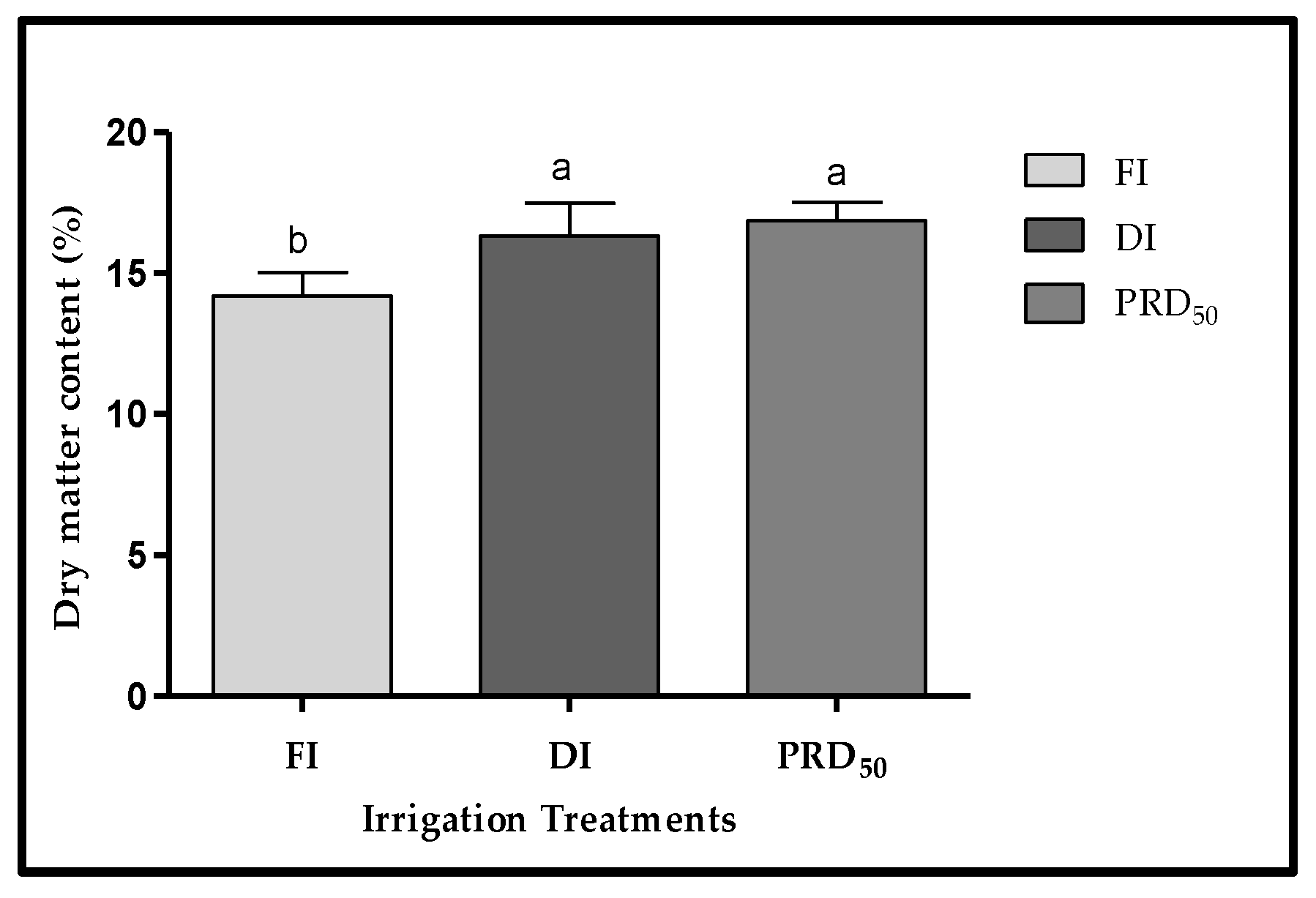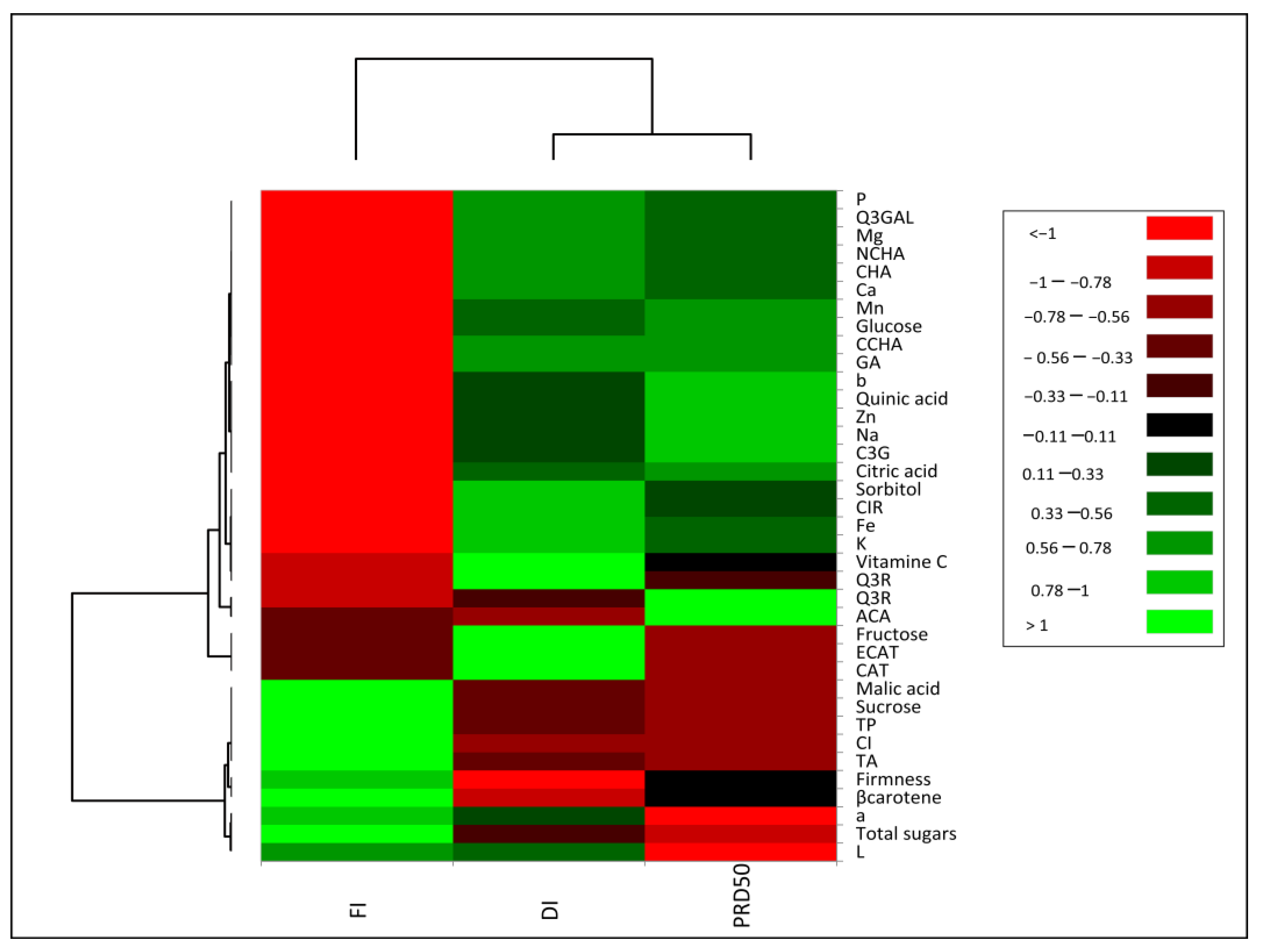Improving Peach Fruit Quality Traits Using Deficit Irrigation Strategies in Southern Tunisia Arid Area
Abstract
:1. Introduction
2. Materials and Methods
2.1. Field Conditions and Plant Material
2.2. Irrigation Treatments
2.3. Sample Preparation and Quality Traits
2.4. Metabolic Analyses
2.4.1. Sugars and Organic Acid Metabolites
2.4.2. Secondary Metabolites
2.4.3. Mineral Content
2.5. Statistical Analysis
3. Results
3.1. Meteorological Conditions and Irrigation Applied
3.2. Physical Characteristics of Fruits
3.3. Peach Fruit Sugars and Organic Acid Content
3.4. Secondary Metabolites
3.5. Mineral Content
4. Discussion
5. Conclusions
Supplementary Materials
Author Contributions
Funding
Institutional Review Board Statement
Informed Consent Statement
Data Availability Statement
Acknowledgments
Conflicts of Interest
Abbreviations
References
- IPCC. Climate Change 2013. The Physical Science Basis Contribution of Working Group to the Fifth Assessment Report of the Intergouvernmental Panel on Climate Change; Cambridge University Press: Cambridge, UK, 2013. [Google Scholar]
- Spinoni, J.; Vogt, J.; Barbosa, P. European degree-day climatologies and trends for the period 1951–2011. Int. J. Climatol. 2015, 35, 25–36. [Google Scholar] [CrossRef] [Green Version]
- Saadi, S.; Simonneaux, V.; Boulet, G.; Raimbault, B.; Mougenot, B.; Fanise, P.; Ayari, H.; Lili-Chabaane, Z. Monitoring irrigation consumption using high resolution NDVI image time series: Calibration and validation in the Kairouan Plain (Tunisia). Remote Sens. 2015, 7, 13005–13028. [Google Scholar] [CrossRef] [Green Version]
- Giuliani, M.; Anghileri, D.; Castelletti, A.; Vu, P.N.; Soncini-Sessa, R. Large storage operations under climate change: Expanding uncertainties and evolving trade offs. Environ. Res. Lett. 2016, 11, 35009. [Google Scholar] [CrossRef]
- FAO. 2. United Nations 2017. 2016. Available online: http://www.fao.org/nr/water/aquastat/tables/WorldData-Irrigation_eng.pdf (accessed on 13 February 2019).
- Cominelli, E.; Galbiati, M.; Tonelli, C.; Bowler, C. Water: The invisible problem. EMBO Rep. 2009, 10, 671–676. [Google Scholar] [CrossRef] [PubMed] [Green Version]
- Zarrouk, O.; Brunetti, C.; Egipto, R.; Pinheiro, C.; Genebra, T.; Gori, A.; Lopes, C.; Tattini, M.; Chaves, M.M. Grape Ripening Is Regulated by Deficit Irrigation/Elevated Temperatures According to Cluster Position in the Canopy. Front. Plant Sci. 2016, 7, 1640. [Google Scholar] [CrossRef] [Green Version]
- McCarthy, M.G.; Loveys, B.R.; Dry, P.R.; Stoll, M. Regulated deficit irrigation and partial root zone drying as irrigation management techniques for grapevines. In Deficit Irrigation Practices; FAO Water Reports No. 22; FAO: Rome, Italy, 2002; pp. 79–87. [Google Scholar]
- Dry, P.R.; Loveys, B.R. Grapevine shoot growth and stomatal conductance are reduced when part of the root system is dried. Vitis 1999, 38, 151–156. [Google Scholar]
- Loveys, B.; Stoll, M.; Davis, W.J. Physiological approaches to enhance water use efficiency in agriculture: Exploiting plant signalling in novel irrigation practice. In Water Use Efficiency in Plant Biology; Bacon, M., Ed.; Blackwell Publishing: Oxford, UK, 2004; pp. 113–141. [Google Scholar]
- Jovanovic, Z.; Stikic, R. Partial root-zone drying technique: From water saving to the improvement of a fruit quality. Front. Sustain. Food Syst. 2018, 3, 1–9. [Google Scholar] [CrossRef] [Green Version]
- Flamini, R.; Rosso, M.; Marchi, F.; Vedova, A.; Panighel, A.; Gardiman, M.; Maoz, I.; Bavaresco, I. An innovative approach to grape metabolomics: Stilbene profiling by suspect screening analysis. Metabolomics 2013, 9, 1243–1253. [Google Scholar] [CrossRef]
- Du, S.; Kang, S.; Li, F.; Du, T. Water use efficiency is improved by alternate partial root-zone irrigation of apple in arid northwest China. Agric. Water Manag. 2017, 179, 184–192. [Google Scholar] [CrossRef]
- Chaves, M.M.; Zarrouk, O.; Francisco, R.; Costa, J.M.; Santos, T.; Regalado, A.P.; Rodrigues, M.L.; Lopes, C.M. Grapevine under deficit irrigation: Hints from physiological and molecular data. Ann. Bot. 2010, 105, 661–676. [Google Scholar] [CrossRef] [Green Version]
- Zarrouk, O.; Francisco, R.; Pinto-Marijuan, M.; Brossa, R.; Santos, R.R.; Pinheiro, C.; Costa, J.M.; Lopes, C.; Chaves, M.M. Impact of irrigation regime on berry development and flavonoids composition in Aragonez (Syn. Tempranillo) grapevine. Agric. Water Manag. 2012, 114, 18–29. [Google Scholar] [CrossRef]
- Romero, P.; Pérez-Pérez, J.G.; Del Amor, F.M.; Martinez-Cutillas, A.; Dodd, I.C.; Botía, P. Partial root zone drying exerts different physiological responses on field-grown grapevine (Vitis vinifera cv. Monastrell) in comparison to regulated deficit irrigation. Funct. Plant Biol. 2014, 41, 1087–1106. [Google Scholar] [CrossRef] [PubMed]
- Tavarini, S.; Gil, M.I.; Tomas-Barberan, F.A.; Buendia, B.; Remorini, D.; Massai, R.; Degll’ Innocenti, E.; Guidi, L. Effects of water stress and rootstocks on fruit phenolic composition and physical/chemical quality in suncrest peach. Ann. Appl. Biol. 2011, 158, 226–233. [Google Scholar] [CrossRef]
- Rahmati, M.; Vercambre, G.; Davarynejad, G.; Bannayan, M.; Azizi, M.; Gènard, M. Water scarcity conditions affect peach fruit size and polyphenol contents more severely than other fruit quality traits. J. Sci. Food. Agric. 2015, 95, 1055–1065. [Google Scholar] [CrossRef]
- DGPA. Statistiques Agricoles 2019 [Agricultural Statistics 2019]; Direction Générale de la Production Agricole, Ministère de l’Agriculture: Tunisie, Tunis, 2019.
- El Mokh, F.; Nagaz, K.; Masmoudi, M.M.; Ben Mechlia, N.; Ghiglieri, G. Deficit Irrigation Using Saline Water of Fruit Trees under Water Scarcity Conditions of Southern Tunisia. Atmosphere 2021, 12, 864. [Google Scholar] [CrossRef]
- Allen, R.G.; Pereira, J.S.; Raes, D.; Smith, M. Crop Evapotranspiration: Guidelines for Computing Crop Water Requirements; Food and Agriculture Organization of the United Nations: Rome, Italy, 1998; Volume 56, pp. 300–301. [Google Scholar]
- Fereres, E.; Goldhamer, D.A. Deciduous fruit and nuts trees. Irrig. Agric. Crops 1990, 30, 987–1017. [Google Scholar]
- Cai, Y.Z.; Luo, Q.; Sun, M.; Corke, H. Antioxidant activity and phenolic compounds of 112 traditional Chinese medicinal plants associated with anticancer. Life Sci. 2004, 74, 2157–2184. [Google Scholar] [CrossRef]
- Iglesias, I.; Gine-Bordonaba, J.; Garanto, X.; Reig, G. Rootstock affects quality and phytochemical composition of ‘Big Top’ nectarine fruits grown under hot climatic conditions. Sci. Hortic. 2019, 256, 108586. [Google Scholar] [CrossRef]
- Thompson, K.A.; Marshall, M.R.; Sims, C.A.; Wei, C.I.; Sargent, S.A.; Scott, J.W. Cultivar, maturity and heat treatment on lycopene content in tomatoes. J. Food Sci. 2000, 65, 791–795. [Google Scholar] [CrossRef]
- El Falleh, W.; Tlili, N.; Ying, M.; Sheng-Hua, H.; Ferchichi, A.; Nasri, N. Organoleptic quality, minerals, proteins and amino acids from two tunisian commercial pomegranate fruits. Int. J. Food Eng. 2011, 7, 13. [Google Scholar] [CrossRef]
- Kozlowski, J. Optimal allocation of resources to growth and reproduction: Implications for age and size at maturity. Trends Ecol. Evol. 1992, 7, 9–15. [Google Scholar] [CrossRef]
- Lopez, G.; Behboudian, M.H.; Vallverdu, X.; Mata, M.; Girona, J.; Marsal, J. Mitigation of severe water stress by fruit thinning in O’Henry’ peach: Implications for fruit quality. Sci. Hortic. 2010, 125, 294–300. [Google Scholar] [CrossRef]
- Reid, M.; Kalcsits, L. Water Deficit Timing Affects Physiological Drought Response, Fruit Size, and Bitter Pit Development for ‘Honeycrisp’ Apple. Plants 2020, 9, 874. [Google Scholar] [CrossRef] [PubMed]
- Ripoll, J.; Urban, L.; Staudt, M.; Lopez-Lauri, F.; Bidel, L.P.; Bertin, N. Water shortage and quality of fleshy fruits--making the most of the unavoidable. J. Exp. Bot. 2014, 65, 4097117. [Google Scholar] [CrossRef] [Green Version]
- Aurand, R.; Faurobert, M.; Page, D.; Maingonnat, J.F.; Brunel, B.; Causse, M.; Bertin, N. Anatomical and biochemical trait network underlying genetic variations in tomato fruit texture. Springer 2012, 187, 99–116. [Google Scholar] [CrossRef]
- Nardoza, S.; Gamble, J.; Axten, L.; Wohlers, M.W.; Clearwater, M.J.; Feng, J.; Harker, F.R. Dry matter content and fruit size affect flavor and texture of novel Acitindia deliciosa genotypes. J. Sci. Food Agric. 2010, 91, 742–748. [Google Scholar] [CrossRef]
- Lobos, T.E.; Retamales, J.B.; Ortega-Farías, S.; Hanson, E.J.; Lopez-Olivari, R.; Mora, M.L. Regulated deficit irrigation effects on physiological parameters, yield, fruit quality and antioxidants of Vaccinium corymbosum plants cv. Brigitta. Irrig. Sci. 2018, 36, 49–60. [Google Scholar] [CrossRef]
- Ordóñez-Díaz, J.L.; Pereira-Caro, G.; Cardeñosa, V.; Muriel, J.L.; Moreno-Rojas, J.M. Study of the Quality Attributes of Selected Blueberry (Vaccinium corymbosum L.) Varieties Grown under Different Irrigation Regimes and Cultivation Systems. Appl. Sci. 2020, 10, 8459. [Google Scholar] [CrossRef]
- Gribaa, A.; Dardelle, F.; Lehner, A.; Rihouey, C.; Burel, C.; Ferchichi, A.; Driouich, A.; Mollet, J.C. Effect of water deficit on the cell wall of the date palm (Phoenix dactylifera ‘Deglet nour’, Arecales) fruit during development. Plant Cell Environ. 2013, 36, 1056–1070. [Google Scholar] [CrossRef]
- Rato, A.E.; Numes, C.; Aguelheiro-Santos, A.C.; Barroso, J.M.; Riquelme, F.; Coimbra, M.A. Influence of cell wall calcuim content in fruit firmness during the ripening of plums (Prunus domestica L.). In Proceedings of the XXVIII International Horticultural Congress on Science and Horticulture for People, Lisbon, Portugal, 22–27 August 2012. [Google Scholar] [CrossRef] [Green Version]
- Hocking, B.; Tyerman, S.D.; Burton, R.A.; Gilliham, M. Fruit Calcium: Transport and Physiology. Front. Plant Sci. 2016, 7, 569. [Google Scholar] [CrossRef] [Green Version]
- Manganaris, G.A.; Vasilakakis, M.; Mignani, I.; Diamantidis, G.; Tzavella-Klonari, K. The effect of preharvest calcium sprays on quality attributes, physicochemical aspects of cell wall components and susceptibility to brown rot of peach fruits (Prunus persica L. cv. Andross). Sci. Hortic. 2005, 107, 43–50. [Google Scholar] [CrossRef]
- Lopez, G.; Behboudian, M.H.; Echeverria, G.; Girona, J.; Marsal, J. Instrumental and sensory evaluation of fruit quality for ‘Ryan’s Sun’ peach grown under deficit irrigation. HortTechnology 2011, 21, 2171–2719. [Google Scholar] [CrossRef] [Green Version]
- Kader, A.A. Biochemical and Physiological Basis for Effects of Controlled and Modified Atmospheres on Fruits and Vegetables. Food Technol. 1986, 40, 99–104. [Google Scholar]
- Beckles, D.M. Factors Affecting the Postharvest Soluble Solids and Sugar Content of Tomato (Solanum lycopersicum L.) Fruit. Postharvest Biol. Technol. 2012, 63, 129–140. [Google Scholar] [CrossRef]
- Esti, M.; Messia, M.C.; Sinesio, F.; Nicotra, A.; Conte, L.; La Notte, E.; Palleschi, G. Quality evaluation of peaches and nectarines by electrochemical and multivariate analyses: Relationships between analytical measurements and sensory attributes. Food Chem. 1997, 60, 659–666. [Google Scholar] [CrossRef]
- Adu, M.O.; Yawson, D.O.; Abano, E.E.; Asare, P.A.; Armah, F.A.; Opuku, E.K. Does water-saving irrigation improve the quality of fruits and vegetables? Evidence from meta-analysis. Irrig. Sci. 2019, 37, 669–690. [Google Scholar] [CrossRef]
- Faci, J.M.; Medina, E.T.; Martínez-Cob, A.; Alonso, J.M. Fruit yield and quality response of a late season peach orchard to different irrigation regimes in a semi-arid environment. Agric. Water Manag. 2014, 143, 102–112. [Google Scholar] [CrossRef] [Green Version]
- Santos, T.P.; Lopes, C.M.; Rodrigues, M.L.; De Souza, C.R.; Ricardo-Da-Silva, J.M.; Maroco, J.P.; Pereira, J.S.; Chaves, M.M. Effects of partial root-zone drying irrigation on cluster microclimate and fruit composition of Castelão field-grown grapevines. Vitis 2005, 44, 117–125. [Google Scholar] [CrossRef]
- Léchaudel, M.; Joas, J.; Caro, Y.; Génard, M.; Jannoyer, M. Leaf:fruit ratio and irrigation supply affect seasonal changes in minerals, organic acids and sugars of mango fruit. J. Sci. Food Agric. 2005, 85, 251–260. [Google Scholar] [CrossRef]
- Romero, P.; Navarro, J.M.; Pérez-Pérez, J.; García-Sánchez, F.; Gómez-Gómez, A.; Porras, I.; Martinez, V.; Botía, P. Deficit irrigation and rootstock: Their effects on water relations, vegetative development, yield, fruit quality and mineral nutrition of Clemenules mandarin. Tree Physiol. 2006, 26, 1537–1548. [Google Scholar] [CrossRef]
- Intrigliolo, D.S.; Castel, J.R. Response of plum trees to deficit irrigation under two crop levels: Tree growth, yield and fruit quality. Irrig. Sci. 2010, 28, 525–534. [Google Scholar] [CrossRef]
- Moing, A.; Carbonne, F.; Zipperlin, B.; Svanella, L.; Gaudillère, J.P. Phloem loading in peach: Symplastic or apoplastic? Physiol. Plant 1997, 101, 489–496. [Google Scholar] [CrossRef]
- Noiraud, N.; Maurousset, L.; Lemoine, R.M. Transport of polyols in higher plants. Plant Physiol. Biochem. 2001, 39, 717–728. [Google Scholar] [CrossRef]
- Lo Bionco, R.; Rieger, M.; Sung, S.S. Effect of drought on sorbitol and sucrose metabolism in sinks and sources of peach. Physiol. Plant 2000, 108, 71–78. [Google Scholar] [CrossRef]
- Bieleski, R.L.; Redgwell, R.J. Sorbitol versus sucrose as photosynthesis and translocation products in developing apricot leaves. Funct. Plant Biol. 1985, 12, 657–668. [Google Scholar] [CrossRef]
- Wu, J.; Gao, H.; Zhao, L.; Liao, X.; Chen, F.; Wang, Z.; Hu, X. Chemical compositional characterization of some apple cultivars. Food Chem. 2007, 103, 88–93. [Google Scholar] [CrossRef]
- Toumi, I.; Ghrab, M.; Nagaz, K. Vegetative growth, yield, and water productivity of an early maturing peach cultivar under deficit irrigation strategies in a warm and arid area. Irrig. Drain. 2022, 71, 1–10. [Google Scholar] [CrossRef]
- Cuéllar, T.; Azeem, F.; Andrianteranagna, M.; Pascaud, F.; Verdeil, J.L.; Sentenac, H.; Zimmermann, S.; Gaillard, I. Potassium transport in developing fleshy fruits: The grapevine inward K+ channel VvK1.2 is activated by CIPK–CBL complexes and induced in ripening berry flesh cells. Plant J. 2013, 73, 1006–1018. [Google Scholar] [CrossRef]
- Rogiers, S.Y.; Coetzee, Z.A.; Walker, R.R.; Deloire, A.; Tyerman, S.D. Potassium in the grape (Vitis vinifera L.) berry: Transport and function. Front. Plant Sci. 2017, 8, 1629. [Google Scholar] [CrossRef]
- Nieves-Cordones, M.; Andrianteranagna, M.; Cuéllar, T.; Chérel, I.; Gibrat, R.; Boeglin, M.; Moreau, B.; Pris, N.; Verdell, J.L.; Dgmar Zimmermann, S.; et al. Characterization of the grapevine Shaker K+ channel VvK3.1 supports its function in massive potassium fluxes necessary for berry potassium loading and pulvinus-actuated leaf movements. New Phytol. 2019, 222, 286–300. [Google Scholar] [CrossRef]
- Pangborn, R.M. Relative Taste Intensities of Selected Sugars and Organic Acids. Food Sci. 1963, 28, 726–733. [Google Scholar] [CrossRef]
- Falagán, N.; Artés, F.; Gómez, P.A.; Artés-Hernández, F.; Conejero, W.; Aguayo, E. Deficit irrigation strategies enhance health-promoting compounds through the intensification of specific enzymes in early peaches. J. Sci. Food Agric. 2016, 96, 1803–1813. [Google Scholar] [CrossRef] [PubMed]
- Zhou, H.; Lin-Wang, H.K.; Wang, H.; Gu, C.; Dare, A.P.; Espley, R.V.; He, H.; Allan, A.C.; Han, Y. Molecular genetics of blood-fleshed peach reveals activation of anthocyanin biosynthesis by NAC transcription factors. Plant J. 2015, 82, 105–121. [Google Scholar] [CrossRef] [PubMed]
- Jiang, W.; Li, N.; Zhang, D.; Meinhardt, L.; Cao, B.; Li, Y.; Song, L. Elevated temperature and drought stress significantly affect fruit quality and activity of anthocyanin-related enzymes in jujube (Ziziphus jujuba Mill. cv. ‘Lingwuchangzao’). PLoS ONE 2020, 15, e0241491. [Google Scholar] [CrossRef]
- Zhou, D.; Li, R.; Zhang, H.; Chen, S.; Tu, K. Hot air and UV-C treatments promote anthocyanin accumulation in peach fruit through their regulations of sugars and organic acids. Food Chem. 2020, 309, 125726. [Google Scholar] [CrossRef]
- Sadras, V.O.; Moran, M.A. Elevated temperature decouples anthocyanins and sugars in berries of Shiraz and Cabernet Franc. Aust. J. Grape Wine Res. 2012, 18, 115–122. [Google Scholar] [CrossRef]
- Bai, Q.; Shen, Y.; Huang, Y. Advances in Mineral Nutrition Transport and Signal Transduction in Rosaceae Fruit Quality and Postharvest Storage. Front. Plant Sci. 2021, 12, 620018. [Google Scholar] [CrossRef]
- Lewinsohn, E.; Sitrit, Y.; Bar, E.; Azulay, Y.; Ibdah, M.; Meir, A.; Yosef, E.; Zamir, D.; Tadmor, Y. Not just colors-carotenoid degradation as a link between pigmentation and aroma in tomato and watermelon fruit. Trends Food Sci. Technol. 2005, 16, 407–415. [Google Scholar] [CrossRef]
- Buendía, B.; Allende, A.; Nicolás, E.; Alarcón, J.J.; Gil, M.I. Effect of regulated deficit irrigation and crop load on the antioxidant compounds of peaches. J. Agric. Food Chem. 2008, 56, 3601–3608. [Google Scholar] [CrossRef]
- Bindon, K.A.; Dry, P.R.; Loveys, B.R. Influence of plant water status on the production of C13-norisoprenoid precursors in Vitis vinifera L. cv. Cabernet Sauvignon grape berries. J. Agric. Food Chem. 2007, 55, 4493–4500. [Google Scholar] [CrossRef]
- Perin, E.C.; Da Silva Messias, R.; Borowski, J.M.; Crizel, R.L.; Schott, I.B.; Carvalho, I.R.; Rombaldi, C.V.; Galli, V. ABA-dependent salt and drought stress improve strawberry fruit quality. Food Chem. 2019, 271, 516–526. [Google Scholar] [CrossRef] [PubMed]
- Pernice, R.; Parisi, M.; Giordano, I.; Pentangelo, A.; Graziani, G. Antioxidants profile of small tomato fruits: Effect of irrigation and industrial process. Sci. Hortic. 2010, 126, 156–163. [Google Scholar] [CrossRef]
- Zhang, Y.; Wang, Y.; Chen, D.; Yu, B.; Zheng, P.; Mao, X.; Luo, Y.; Li, Y.; He, J. Dietary chlorogenic acid supplementation affects gut morphology, antioxidant capacity and intestinal selected bacterial populations in weaned piglets. Food Funct. 2018, 9, 49684–49978. [Google Scholar] [CrossRef] [PubMed]
- Villarino, M.; Sandín-España, P.; Melgarejo, P.; De Cal, A. High chlorogenic and neochlorogenic acid levels in immature peaches reduce Monilinia laxa infection by interfering with fungal melanin biosynthesis. J. Agric. Food Chem. 2011, 59, 3205–3213. [Google Scholar] [CrossRef] [PubMed]
- Patanè, C.; Siah, S.; Pellegrino, A.; Cosentino, S.L.; Siracusa, L. Fruit Yield, Polyphenols, and Carotenoids in Long Shelf-Life Tomatoes in Response to Drought Stress and Rewatering. Agronomy 2021, 11, 1943. [Google Scholar] [CrossRef]
- Agbemafle, R.; Owusu-Sekyere, J.D.; Bart-Plang, A. Effect of defcit irrigation and storage on the nutritional composition of tomato (Lycopersicon esculentum Mill. cv. Pectomech). Croat. J. Food Technol. Biotechnol. Nutr. 2015, 10, 59–65. [Google Scholar]
- Lipan, L.; Cano-Lamadrid, M.; Corell, M.; Sendra, E.; Hernández, F.; Stan, L.; Vodnar, D.C.; Vázquez-Araújo, L.; Carbonell-Barrachina, Á.A. Sensory profile and acceptability of hydrosostainable almonds. Foods 2019, 8, 64. [Google Scholar] [CrossRef] [Green Version]
- Falchi, R.; Bonghi, C.; Drincovich, M.F.; Famiani, F.; Lara, M.V.; Walker, R.P.; Vizzotto, G. Sugar metabolism in stone fruit: Source-sink relationships and environmental and agronomical effects. Front. Plant Sci. 2020, 11, 573982. [Google Scholar] [CrossRef]
- Singh, G.; Kachwaya, D.S.; Kuchi, V.S.; Singh, M.; Singh, J.; Singh, B. Influence of foliar application of mineral nutrients on vegetative and fruit quality of strawberry (Fragaria × ananassa Duch.) cv. Chandler. J. Plant Sci. Res. 2020, 36, 323–328. [Google Scholar] [CrossRef]








| Irrigation Treatment | Phenological Stage | Total | |||
|---|---|---|---|---|---|
| Bud Break–Full Bloom | Full Bloom–Fruit Set | Fruit Set–Harvest | Post-Harvest | ||
| FI | 85.25 | 102.50 | 196.85 | 597.50 | 982.14 |
| DI | 42.63 | 51.25 | 98.42 | 298.76 | 491.07 |
| PRD50 | 42.63 | 51.25 | 98.42 | 298.76 | 491.07 |
| Irrigation Treatment | SSC | Sugars (g 100 g−1 DM) | Total Sugars (g 100 g−1 DM) | |||
|---|---|---|---|---|---|---|
| (°Brix) | Sucrose | Fructose | Glucose | Sorbitol | ||
| FI | 12.3 ± 0.72 b | 54.28 ± 5.66 a | 7.40 ± 0.84 ab | 7.78 ± 0.74 b | 2.73 ± 0.66 a | 72.18 ± 3.63 a |
| DI | 14.3 ± 0.15 a | 46.04 ± 4.28 a | 8.55 ± 0.58 a | 9.93 ± 1.27 a | 3.42 ± 0.37 a | 67.94 ± 4.27 a |
| PRD50 | 14.0 ± 0.45 a | 45.30 ± 3.65 a | 7.39 ± 0.26 b | 10.11 ± 0.63 a | 3.18 ± 0.70 a | 65.74 ± 4.32 a |
| Significance | * | ns | * | * | ns | ns |
| Irrigation Treatment | FI | DI | PRD50 | Significance |
|---|---|---|---|---|
| Phenolic acid | ||||
| GA | 0.14 ± 0.03 b | 0.28 ± 0.08 a | 0.28 ± 0.03 a | * |
| Hydrocinnamic acids | ||||
| CCHA | 85.42 ± 13.05 b | 153.49 ± 53.31 a | 154.82 ± 37.19 a | * |
| CHA | 0.26 ± 0.07 b | 0.67 ± 0.14 a | 0.62 ± 0.12 a | * |
| NCHA | 0.09 ± 0.1 b | 0.22 ± 0.04 a | 0.20 ± 0.03 a | ** |
| Flavan-3-ols | ||||
| CAT | 3.63 ± 0.62 b | 5.15 ± 0.34 a | 3.34 ± 0.51 b | * |
| ECAT | 0.08 ± 0.006 b | 0.14 ± 0.130 a | 0.07 ± 0.026 b | ** |
| Anthocyanin | ||||
| C3G | 0.17 ± 0.03 b | 0.32 ± 0.04 a | 0.37 ± 0.04 a | ** |
| Flavonols | ||||
| Q3GAL | 1.98a ± 0.52 a | 3.64a ± 1.07 a | 3.52a ± 0.92 a | ns |
| Q3R | 0.70b ± 0.24 b | 2.25a ± 0.36 a | 1.32b ± 0.32 b | ** |
| Flavones | ||||
| CIR | 0.44 ± 0.07 a | 0.57 ± 0.08 a | 0.53 ± 0.03 a | ns |
| ACA | 5.18 ± 0.55 a | 5.06 ± 0.31 a | 5.67 ± 0.53 a | ns |
| Other antioxidants | ||||
| Vitamin C | 42.82 ± 8.97 a | 53.89 ± 8.16 a | 48.26 ± 11.62 a | ns |
| β-Carotene | 0.71 ± 0.15 a | 0.21 ± 0.02 c | 0.43 ± 0.05 b | ** |
| TP | 724.49 ± 69.49 a | 706.58 ± 49.49 a | 704.00 ± 22.94 a | ns |
Publisher’s Note: MDPI stays neutral with regard to jurisdictional claims in published maps and institutional affiliations. |
© 2022 by the authors. Licensee MDPI, Basel, Switzerland. This article is an open access article distributed under the terms and conditions of the Creative Commons Attribution (CC BY) license (https://creativecommons.org/licenses/by/4.0/).
Share and Cite
Toumi, I.; Zarrouk, O.; Ghrab, M.; Nagaz, K. Improving Peach Fruit Quality Traits Using Deficit Irrigation Strategies in Southern Tunisia Arid Area. Plants 2022, 11, 1656. https://doi.org/10.3390/plants11131656
Toumi I, Zarrouk O, Ghrab M, Nagaz K. Improving Peach Fruit Quality Traits Using Deficit Irrigation Strategies in Southern Tunisia Arid Area. Plants. 2022; 11(13):1656. https://doi.org/10.3390/plants11131656
Chicago/Turabian StyleToumi, Ines, Olfa Zarrouk, Mohamed Ghrab, and Kamel Nagaz. 2022. "Improving Peach Fruit Quality Traits Using Deficit Irrigation Strategies in Southern Tunisia Arid Area" Plants 11, no. 13: 1656. https://doi.org/10.3390/plants11131656
APA StyleToumi, I., Zarrouk, O., Ghrab, M., & Nagaz, K. (2022). Improving Peach Fruit Quality Traits Using Deficit Irrigation Strategies in Southern Tunisia Arid Area. Plants, 11(13), 1656. https://doi.org/10.3390/plants11131656






